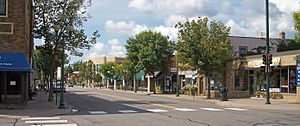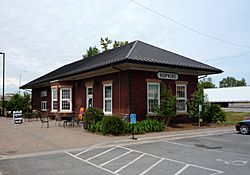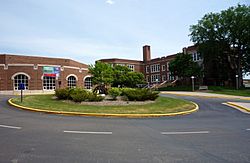Hopkins, Minnesota facts for kids
Quick facts for kids
Hopkins
|
||
|---|---|---|
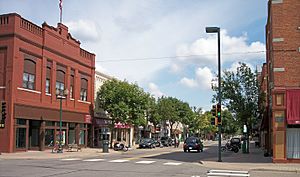
Downtown Hopkins
|
||
|
||
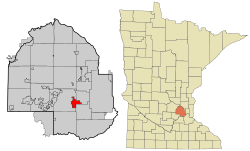
Location of Hopkins
within Hennepin County, Minnesota |
||
| Country | United States | |
| State | Minnesota | |
| County | Hennepin | |
| Founded | 1852 | |
| Incorporated | November 27, 1892 (as West Minneapolis) | |
| Incorporated | July 7, 1928 (as Hopkins) | |
| Incorporated | December 2, 1947 | |
| Area | ||
| • City | 4.09 sq mi (10.60 km2) | |
| • Land | 4.06 sq mi (10.52 km2) | |
| • Water | 0.03 sq mi (0.08 km2) | |
| Elevation | 1,027 ft (313 m) | |
| Population
(2020)
|
||
| • City | 19,079 | |
| • Estimate
(2022)
|
18,269 | |
| • Density | 4,500/sq mi (1,736/km2) | |
| • Urban | 2,914,866 | |
| • Metro | 3,693,729 | |
| Time zone | UTC-6 (Central (CST)) | |
| • Summer (DST) | UTC-5 (CDT) | |
| ZIP codes |
55305, 55343, 55345
|
|
| Area code(s) | 952 | |
| FIPS code | 27-30140 | |
| GNIS feature ID | 0645180 | |
| Sales tax | 8.525% | |
Hopkins is a suburban city in Hennepin County, Minnesota, United States, located west of Minneapolis. The population was 19,079 at the 2020 census. The city is four square miles in size and is surrounded by the larger suburban communities of Minnetonka, Saint Louis Park, and Edina. The city's main street was added to the National Register of Historic Places in 2022 as the Hopkins Commercial Historic District.
Contents
Geography
According to the United States Census Bureau, the city has a total area of 4.11 square miles (10.64 km2), of which 4.08 square miles (10.57 km2) is land and 0.03 square miles (0.08 km2) is water. There are several small ponds on the western side of Hopkins, and creeks to the north and south. One of these creeks includes Minnehaha Creek. The north branch of Nine Mile Creek has its headwaters in Hopkins at the intersection of 13th Avenue South and Excelsior Boulevard.
The southern end of Hopkins is adjacent to main line of the Twin Cities and Western Railroad. Two main highways, U.S. Route 169 and Minnesota State Highway 7, service the Hopkin's area.
Hopkins will have three stations on the Southwest LRT. There will be stations at Shady Oak Road, Downtown Hopkins, and at Blake Road.
Demographics
| Historical population | |||
|---|---|---|---|
| Census | Pop. | %± | |
| 1900 | 1,648 | — | |
| 1910 | 3,022 | 83.4% | |
| 1920 | 3,055 | 1.1% | |
| 1930 | 3,834 | 25.5% | |
| 1940 | 4,100 | 6.9% | |
| 1950 | 7,595 | 85.2% | |
| 1960 | 11,370 | 49.7% | |
| 1970 | 13,428 | 18.1% | |
| 1980 | 15,336 | 14.2% | |
| 1990 | 16,534 | 7.8% | |
| 2000 | 17,145 | 3.7% | |
| 2010 | 17,591 | 2.6% | |
| 2020 | 19,079 | 8.5% | |
| 2022 (est.) | 18,269 | 3.9% | |
| U.S. Decennial Census 2020 Census |
|||
2020 census
As of the census of 2020, there were 19,079 people, and 9,220 households residing in the city. The population density was 4,696.9 inhabitants per square mile (1,813.5/km2). The racial makeup of the city was 64.2% White, 21.5% African American, 0.1% Native American, 7.1% Asian, 5.4% from two or more races, and 8.8% Hispanic or Latino.
The average household size was 2.02, and 22% of persons aged 5 years+, 2017-2021 spoke a language other than English spoken at home.
94.2% of people aged 25 years+, 2017-2021 had a high school graduate or higher. 47.5% of persons aged 25 years+, 2017-2021 had a bachelor's degree or higher. 72.5% population age 16 years+, 2017-2021 were in civilian labor force, compared to 66.1% of all females aged 16 years+.
9.5% of people under age 65 years, 2017-2020 had a disability, and 6.9% of persons under age 65 years, did not have health insurance.
The median household income (in 2021 dollars), 2017-2021 was $60,824. The per capita income in past 12 months (in 2021 dollars), 2017-2021 was $40,770.11.8% of people lived in poverty.
2010 census
As of the census of 2010, there were 17,591 people, 8,366 households, and 3,975 families residing in the city. The population density was 4,311.5 inhabitants per square mile (1,664.7/km2). There were 8,987 housing units at an average density of 2,202.7 per square mile (850.5/km2). The racial makeup of the city was 70.4% White, 13.5% African American, 0.6% Native American, 8.5% Asian, 3.4% from other races, and 3.6% from two or more races. Hispanic or Latino of any race were 7.9% of the population.
There were 8,366 households, of which 24.9% had children under the age of 18 living with them, 31.4% were married couples living together, 12.1% had a female householder with no husband present, 4.0% had a male householder with no wife present, and 52.5% were non-families. 43.4% of all households were made up of individuals, and 11.5% had someone living alone who was 65 years of age or older. The average household size was 2.07 and the average family size was 2.93.
The median age in the city was 34.4 years. 21.1% of residents were under the age of 18; 8.4% were between the ages of 18 and 24; 34.3% were from 25 to 44; 23.4% were from 45 to 64; and 12.6% were 65 years of age or older. The gender makeup of the city was 47.6% male and 52.4% female.
Housing
Hopkins has a much lower homeownership rate than neighboring communities. The city's 39 percent homeownership rate is 22 percentage points less than the 61 percent of St. Louis Park, which has the next lowest rate among Hopkins’ neighbors. Other west metro communities fall in the mid-70 percent range.
Housing also tends to be more affordable than most west metro communities. Hopkins’ $225,200 median value is the lowest among its neighbors. The median housing value for St. Louis Park, which is next lowest, is 6.75 percent higher at $240,400.
History
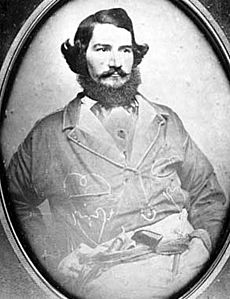
The first non-indigenous settlers in the Hopkins area arrived in 1852 as land around the growing Minneapolis–Saint Paul area was opening up and being explored by members stationed at Fort Snelling. However, the roots of the town begin in 1887 with the building of the Minneapolis Threshing Machine Company, later called Minneapolis-Moline, to make farm equipment. At the time, Minneapolis Moline employed most of the Hopkins residents. In 1887, the West Minneapolis Land Company was founded and formed to build housing for the Minneapolis Moline factory workers.
In 1893, residents of Hopkins sent the Hennepin County Board of Commissioners a petition signed by 41 residents, asking that a separate village be formed from unincorporated portions of then-Minnetonka and Richfield Townships. Following an election, the community was then incorporated as the Village of West Minneapolis with a population of 1,105. The original village consisted of about three-square miles, and it has been enlarged by annexation to its present size of about four-square miles.
In 1928, the name of the village was changed to Hopkins after Harley H. Hopkins, who was among its first homesteaders and was the community's first postmaster. Mr. Hopkins allowed the town to build the train depot on his land (now The Depot Coffee House) with the agreement that the train station would say "Hopkins" on it. People getting off the train assumed the name of the town was Hopkins and it stuck. On January 1, 1948, the village became the city of Hopkins, upon adoption of a council–city manager charter.
Hopkins was the headquarters of Minneapolis-Moline, which was a large manufacturer of tractors and agricultural equipment in the United States until the 1960s.
Timeline
- 1852 – First non-indigenous settlers arrived
- 1862 – First school, Burnes, built
- 1887 – Minneapolis Threshing Machine Company built
- 1893 – November 7, 1,168 people incorporated the village of West Minneapolis
- 1893 – December 9, first city-council elected
- 1899 – Streetcar arrived in West Minneapolis
- 1928 – August 16, village name changed to Hopkins
- 1929 – Minneapolis Threshing Machine Company becomes Minneapolis-Moline
- 1934 – Hopkins business people organized the first Hopkins Raspberry Festival
- 1947 – December 2, Hopkins became a city through the adoption of a city charter
- 2022 - Hopkins Mainstreet designated on the list of the National Register of Historic Places
Hopkins Raspberry Festival
The Hopkins Raspberry Festival is an annual event in Hopkins. The Hopkins Raspberry Festival was founded in 1935 as a way to boost business during the Great Depression of the 1930s. A date of July 21 was chosen to hold the event to coincide with the peak of raspberry-picking season. The festival now takes place the third weekend in July every year.
The Raspberry Festival is overseen by a board of directors supported by many additional volunteers and local civic organizations each year. Since its inception, it has evolved into a dynamic community celebration with activities including music, sporting events, royalty coronations, craft fair, and parade.
National Register of Historic Places
The main street of Hopkins, from 8th to 11th avenues, was officially listed on the National Register of Historic Places in January 2022 as the Hopkins Commercial Historic District. The designation was revealed during a ceremony in April 2022.
Education
Public schools
The Hopkins School District serves all or parts of seven Minneapolis west suburban communities: Hopkins, Minnetonka, Golden Valley, Plymouth, Edina, Eden Prairie, and Saint Louis Park. Approximately 8,100 students attend seven elementary schools (K–fifth grade), two middle schools (6th–8th grade), and one high school (9th–12th grade). Some students attend public schools in other school districts chosen by their families under Minnesota's open enrollment statute, as some students from outside Hopkins school district enroll in Hopkins schools on that basis.
| Schools in the Hopkins School District | ||
|---|---|---|
| Elementary schools | Middle school | Senior high school |
| Alice Smith Elementary | Hopkins West Middle School | Hopkins High School |
| Eisenhower Elementary | Hopkins North Middle School | |
| Gatewood Elementary | ||
| Glen Lake Elementary | ||
| Katherine Curren Elementary (Closed and being rented) | ||
| Meadowbrook Elementary | ||
| L.H. Tanglen Elementary | ||
- located in Minnetonka
- located in Golden Valley
Private schools
There are two private schools in Hopkins:
- The Blake School: A large private school with several campuses throughout the Twin Cities was founded in Hopkins, and the Blake Campus in the city houses both the Middle School and one of its two Lower Schools.
- Chesterton Academy
Agamim Classical Academy was previously located in Hopkins.
Charter schools
- Mainstreet School of Performing Arts (MSSPA): A performing arts school that focuses on the three major performing arts areas; music, dance and theater. The school opened in 2004 and eventually moved to Eden Prairie, MN being renamed to Performing Institute of Minnesota Arts High School (PiM Arts High School). Grades 9–12.
- Ubah Medical Academy is a charter high school currently leasing space in the Katherine Curren Elementary building. The school was chartered in 2003 and was previously housed in Minneapolis.
Notable people
- Ann Bancroft - Teacher at Hopkins Katherine Curren Elementary. Famous Polar Explorer; first woman in history to cross the ice to the North Pole
- Nate Berkus (born 1971) - Interior designer, author and television personality
- Travis Boyd - professional ice hockey player
- Aaron Brown – broadcast journalist on ABC and CNN.[18] Most recognized for his coverage of the September 11, 2001 attacks.
- Paige Bueckers - American college basketball player for the University of Connecticut
- Walter Bush – As a national leader in the growth and development of amateur and professional hockey elected to the U. S. Hockey Hall of Fame in 2000.
- David Carr – Media and culture columnist for The New York Times.[20] Author of a memoir and best seller ‘’The Night of the Gun.’’ Early in his journalist career he was the editor of the ‘’Twin Cities Reader,’’ a weekly alternative newspaper in Minneapolis.
- Amir Coffey - professional basketball player for the Los Angeles Clippers
- Courtney Dauwalter - Ultramarathon runner and former teacher. The only runner in history to win the Hardrock 100, Western States, and UTMB in the same year.
- Daniel Grodnik (movie producer) - Writer/producer of more than 65 films including, National Lampoon's Christmas Vacation, former Chairman/CEO of The National Lampoon and an adjunct professor in producing at the University of Southern California and Chapman University. Went to Alice Smith grade school and Hopkins High. Lettered in ski jumping.
- John Hardgrove – Wisconsin State Assemblyman.
- Samantha Harris – Television hostess and actress. Her most prominent role was as E! Entertainment correspondent and a Dancing with the Stars co-host.
- John B. Keefe - Minnesota state legislator, lawyer, and judge.
- Jerry Knickerbocker - Minnesota state legislator and businessman.
- Peyton Manning - Veteran quarterback and two-time Super Bowl winner who attended Tanglen Elementary School in Hopkins during the time his father, Archie Manning, quarterbacked for the Minnesota Vikings.
- Adele Parkhurst - Soprano concert singer in the 1920s.
- BeBe Shopp – Miss America, 1948.
See also
 In Spanish: Hopkins (Minnesota) para niños
In Spanish: Hopkins (Minnesota) para niños


